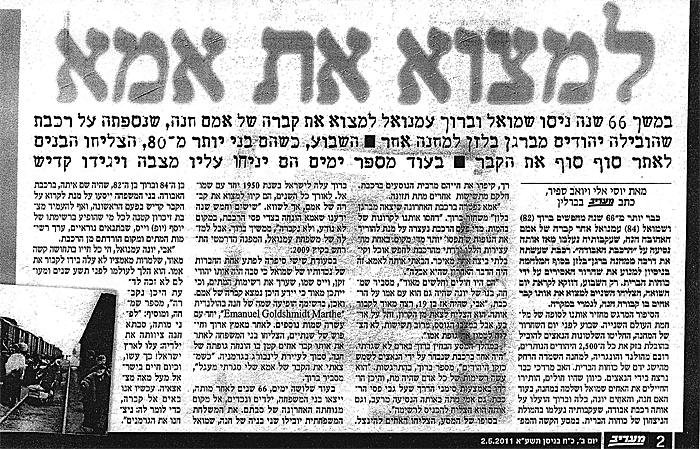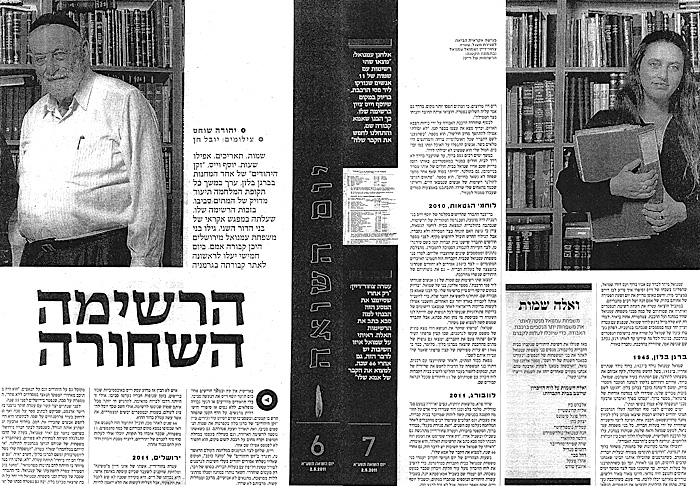![]()
![]()
![]() (Deutsch/English Version)
(Deutsch/English Version)
![]() (Hebrew Version)
(Hebrew Version)
Meine immer noch andauernde Arbeit an der Biographie von Josef Weiss, des letzten Judenältesten von Bergen-Belsen, befasst sich nur bezüglich des Geburtsortes Flamersheim und der Jugendzeit mit regionalhistorischen Aspekten. Nur diese sind ja eigentlich der Schwerpunkt meiner Website. Aber natürlich steht jetzt seine bewundernswerte Haltung in dem berüchtigten Konzentrations- und Vernichtungslager Bergen-Belsen im Vordergrund meiner Untersuchungen.
Da Josef Weiss in der Fachliteratur nur wenige Spuren hinterlassen hat, stellen sich die Recherchen im In- und Ausland als langwierig heraus. Aber immer mehr Augenzeugenberichte, Dokumente und persönliches Hintergrundsmaterial konnten inzwischen mosaikartig zusammengesetzt werden. Aber gleichzeitig ergaben sich viele parallel verlaufende Projekte, in denen Josef Weiss (1893-1976) immer wieder eine Rolle spielte. Das letzte Beispiel liegt erst kurze Zeit zurück und fand Anfang Mai 2011, also erst vor wenigen Tagen, ein zufriedenstellendes Ende.
Am 23. Oktober 2010 publizierte ich auf meiner regionalhistorischen Homepage den Online-Artikel Zum Thema Bergen-Belsen: Auf der Suche nach Marthe (Chana) Emanuel-Goldschmidt, einer vergessenen Toten des Tröbitz-Transportes (1945). Hier ging es um die Suche nach dem Grab einer Frau, die mit dem gleichen Transport wie Josef Weiss am 10. April 1945 Bergen-Belsen verließ, dann aber vier Tage später im sogenannten verlorenen Zug umkam und irgendwo am Bahndamm flüchtig beerdigt wurde. Die Familie meines verdienstvollen jüdischen Mitarbeiters Shmuel Emanuel suchte nun nach vielen Jahrzehnten diese unbekannte Stelle und bemühte sich um eine Gedenktafel für Marthe Emanuel-Goldschmidt und andere Tote, über deren Verbleib man bisher nichts Konkretes wusste. Wie kompliziert ein solches Unterfangen sein kann, beschrieben Shmuel Emanuel und seine Angehörigen in einem englischsprachigen Beitrag, der in dem o. a. Online-Artikel von mir publiziert wurde.
In ihrem Bericht Summary of the efforts made to find the burial site of Mrs. Marthe (Chana) Emanuel-Goldschmidt spielen die Listen von Josef Weiss, dem letzten Judenältesten von Bergen-Belsen, eine wichtige Rolle.
Am 2. Mai 2011 – dem Holocaust Memorial Day (Yom Ha-Shoah) - veröffentlichten die beiden israelischen Zeitungen „Ma`ariv“ sowie „Yedioth Ahronoth“ einen ausführliche Darstellung über die intensive Suche der Familie Emanuel, ihre notwendigen Korrespondenzen und schließlich über den Erfolg. Jetzt endlich gibt es auch ein Gedenken an die letzten Toten des „Lost Train“ von Bergen-Belsen.

Mein persönlicher Kontakt zu Atara Dayan, der Enkelin von Josef Weiss, mit ihrem Archiv und den vielen Aktenordnern, war ein winziger Aspekt bei der Suche. Mihal Emanuel verfasste für die englischsprachige Presse eine Zusammenfassung, in der es u. a. hieß:
... Two years ago, the German researcher Hans-Dieter Arntz from Euskirchen in Germany, made contact with Atara, and told her that he wanted to write a book about her grandfather. He also asked her to look for people who knew her grandfather. A few days later, by Divine Providence, Atara visited a friend in Jerusalem. Her friend was married to Yair Emanuel, who "happened" to be the son of Baruch - one of Marthe's sons. During casual conversation, suddenly it turned out that Yair's father was also on the lost train and knew Josef (Jupp) Weiss.
After Atara Dayan discovered the Emanuels, she came to Shmuel, another Marthe's son, to ask him about her grandfather. Shmuel said that he remembered her grandfather; who was the Judenälteste, and he was very good and special person, and he helped the other Jews in the camp. In the course of the conversation Atara gave Shmuel a binder with letters and documents of Josef Weiss, from the period of the holocaust. Shmuel opened the binder, and to his surprise he found "the list of the deceased from the Lost Train...."
Baruch Emanuel verfasste für die Zeitung „MA'ARIV“ den nun folgenden Beitrag. Auch er befand sich im „verlorenen Zug“, der deswegen so heißt, weil die Russen die am 23. April in Tröbitz befreiten jüdischen Häftlinge wegen der Flecktyphus-Epidemie vollständig isolierten und der Transport daher wochenlang als „verschwunden“ galt:
Mein verdienstvoller jüdischer Mitarbeiter Shmuel Emanuel gehörte zu den wenigen Häftlingen des „Sternlagers“, die in Bergen-Belsen zurückgeblieben waren und todkrank die Befreiung am 15. April 1945 durch die Briten erleben durfte. Er initiierte die Suche seiner umgekommenen Mutter und der anderen vermissten Toten des Transportes. Auf Seite 6 der israelischen Zeitung „YEDIOTH AHRONOTH“ berichtet er von den intensiven Nachforschungen. Auf Seite 7 ist Atara Dayan geb. Zachor abgebildet, die mithilfe der Unterlagen ihres inzwischen berühmten Großvaters Josef Weiss wesentliche Fakten zusammenstellen konnte.

Da die meisten Leser meiner Homepage nicht Hebrew lesen können, soll der gekürzte Inhalt beider Zeitungsartikl auf Englisch zusammengefasst werden:

(English Version)
Establishment a memorial - 66 years after the Holocaust
The Emanuel family was originally from German. The family had 8 kids. (You can read about the family in the book Dignity to Survive.) In 1933 the family escaped to Holland, and they were hiding in Utrecht. Then they were taken to transit camp called ווסטרבורק . Then they were taken to Bergen-Belsen. In Bergen Belsen there were many sub-camps. The Emanuels were in the "Star Camp"
(Sternlager).At the very end of the Second World War, when the Nazis realized that their defeat was imminent, they decided to transfer the inmates of several concentration camps to other camps by trains.
One of the trains, with thousands of inmates from the "Star Camp", that most of them were Jews from Holland, and several hundred sick inmates from the Hungarian Camp - left Bergen-Belsen on April 10. This train was liberated by the Russian army near Troebitz (south of Berlin) after a journey of two weeks. This train was known as "the Lost Train" because even after the allied victory no one knew where it had disappeared in the chaos that reigned in Germany at the end of the war.
Many of the passengers of this train died during the journey, or were killed in Allied air attacks. The bodies were taken off the trains at the Nazis' orders. Some were buried by their fellow passengers next to the tracks, while others were left without burial. The names of the deceased and their places of burial were carefully listed by the other passengers (see below). Hundreds more of those in the Lost Train died after liberation in Troebitz.
Mrs. Chanah Marthe Emanuel-Goldschmidt died in the Lost Train on Shabbat (Saturday), April 14, when the train was in the region of the German town of Lüneburg (approximately 60 km. south-east of Hamburg and 70 km. north-east of Bergen-Belsen). She was 44 years old. Three of her children were with her in the train: Bella (later: Bella Schindler) was with her in the same compartment. Two sons, Yona and Baruch, were in a different compartment. All three were extremely sick and were unable to take care of their mother's body. As far as they knew, the corpse was taken off the train and left without burial.
Shmuel Emanuel, another son, wasn't in the train, but rather stayed in Bergen Belsen.
For Sixty-five years the family had no idea where Marthe's body is.
In summer תשס"ט Shmuel happened to know Atara Dayan, who lives in Kfar Bin-Nun, Israel. Her grandfather was Josef (Jupp) Weiss.
Who was Josef (Jupp) Weiss?
Josef served as the Judenälteste of the Star Camp in Bergen-Belsen and meticulously listed the details of all those who died in the camp. Weiss' notebook in his handwriting still exists, and preserved in the archives of the Ghetto Fighters' House Museum. However, Weiss' lists only go as far as April 4, before the trains left Bergen-Belsen.
Weiss, too, was one of those on the Lost Train, and there he continued to carefully list the names of the deceased and their places of burial. (Weiss himself was sick at the time of that journey, and it is possible that the lists were drawn up at his order, that he did not do it himself.)
The discovery
Two years ago, the German researcher Hans-Dieter Arntz from Euskirchen in Germany, made contact with Atara, and told her that he wanted to write a book about her grandfather. He also asked her to look for people who knew her grandfather.
A few days later, by Divine Providence, Atara visited a friend in Jerusalem. Her friend was married to Yair Emanuel, who "happened" to be the son of Baruch - one of Marthe's sons. During casual conversation, suddenly it turned out that Yair's father was also on the lost train and knew Josef (Jupp) Weiss.After Atara Dayan discovered the Emanuels, she came to Shmuel, another Marthe's son, to ask him about her grandfather. Shmuel said that he remembered her grandfather; who was the Judenälteste, and he was very good and special person, and he helped the other Jews in the camp. In the course of the conversation Atara gave Shmuel a binder with letters and documents of Josef Weiss, from the period of the holocaust.
Shmuel opened the binder, and to his surprise he found "the list of the deceased from the Lost Train" in Dutch. In that list was written that five people who died on 04/14/1945 were buried next to the tracks, including his mother - Marthe. As the result of the surprising discovery, he decided to try to locate the burial place of the mother.
Shmuel and other relatives looked for another documents in the archives of "GFH" (Ghetto Fighters' House Museum). The Emanuels discovered that those bodies in the Lüneburg area, were transferred on October 1945 to burial site Tiergarten in Lüneburg. In this site were buried 244 Neuengamme concentration camp prisoners, including 19 Jews from Budapest, who were killed at the end of the war at the train station in Lüneburg.
The Emanuels turned to the Commissioner of the Municipality Lüneburg cemeteries, and he informed them that they do have documents about the transferring to the Tiergarten cemetery.
But then the Emanuels found additional documents in "GFH"; they found the binder with the documents of Joseph Weiss, but this time it was the original list of the deceased in German. To their disappointment, the Emanuels discovered that in this list was written that Marthe wasn't one of the people who were buried next to the tracks, which meant to them, that her body wasn't taken to Tiergarten. Due to that discovery they concluded that there is no point in continuing their investigation about the burial site.
On Chesvan, one person who has studied the history of the Tiergarten cemetery informed the Emanuels that according to documents, also the bodies that were not buried immediately, were buried afterward by farmers, and were also transferred later to Tiergarten - along with the bodies buried by train passengers. They also found documents that prove that. The investigator informed them that the cemetery area now covered with plants and trees and you can't see the graves.
The family consulted with rabbis, who told them to build a memorial in the cemetery with the names of the 12 victims. After long correspondence, the Emanuels received recently the approval of the municipality for the establishment of the monument.
The exposure of the monument will take place Rosh Chodesh Iyar, May 5 , the 66th יארצייט of Marthe, and the other victims ה' יקום דמם .
